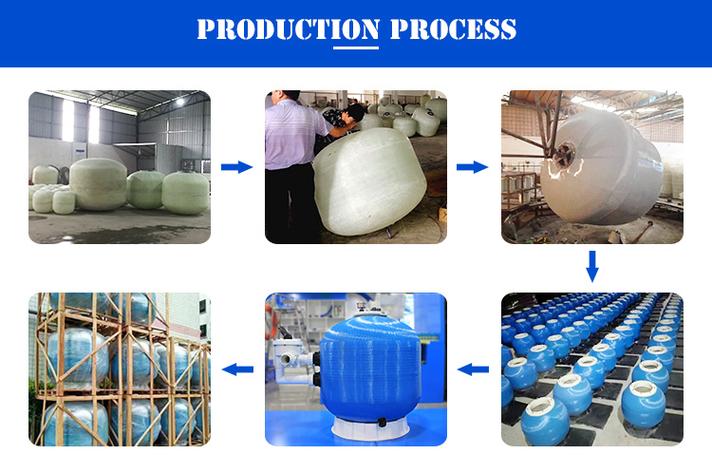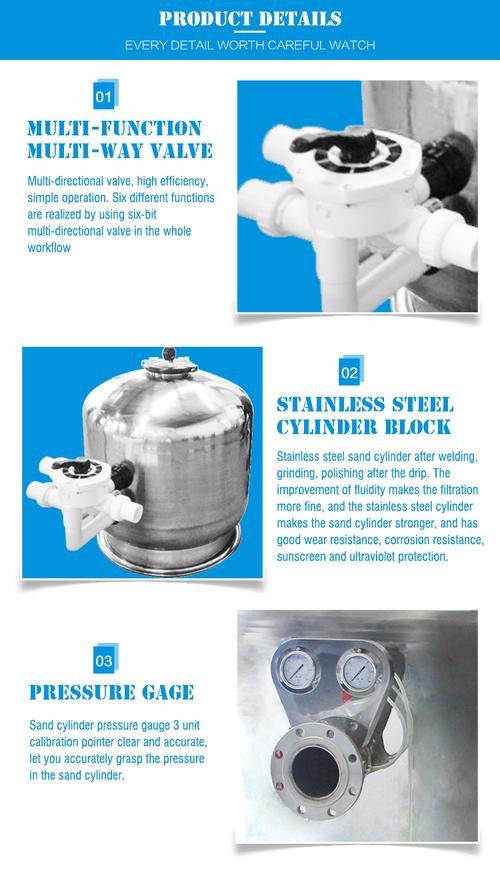Sand Filter Parts for Pool: A Comprehensive Guide
Are you considering a sand filter for your pool? If so, you’ve made a wise choice. Sand filters are highly efficient at removing impurities and maintaining clean, crystal-clear water. To ensure your sand filter operates at its best, it’s crucial to understand its various parts and how they work together. In this article, we’ll delve into the different components of a sand filter for pool, providing you with a detailed and informative overview.
1. The Sand Bed
The heart of a sand filter is its sand bed. This layer of sand, typically made from a fine-grained material like quartz, serves as the primary filtration medium. The sand bed is designed to trap dirt, debris, and other contaminants as water passes through it. The size of the sand particles can vary, but a common range is between 0.15mm and 0.35mm. This allows the sand to effectively capture particles as small as 5 to 10 microns.
It’s essential to use the correct type of sand for your filter. The wrong sand can lead to reduced efficiency and increased maintenance. Always consult your filter’s manufacturer for the recommended sand type and size.
2. The laterals
The laterals are the pipes that distribute water evenly across the sand bed. These pipes are typically made of plastic or metal and are designed to ensure that water flows through the sand bed uniformly. This even distribution is crucial for effective filtration, as it prevents certain areas of the sand bed from becoming overloaded with debris.
When installing a sand filter, it’s important to ensure that the laterals are properly aligned and securely attached to the filter body. This will help maintain optimal water flow and filtration efficiency.

3. The filter body
The filter body is the main container that holds the sand bed and laterals. It is usually made of plastic or fiberglass and comes in various sizes to accommodate different pool sizes. The filter body is designed to withstand the pressure of water flowing through the sand bed and laterals.
When selecting a filter body, consider the size of your pool and the flow rate of your pump. A filter body that is too small may not provide adequate filtration, while one that is too large may be inefficient and costly to operate.
4. The laterals
The laterals are the pipes that distribute water evenly across the sand bed. These pipes are typically made of plastic or metal and are designed to ensure that water flows through the sand bed uniformly. This even distribution is crucial for effective filtration, as it prevents certain areas of the sand bed from becoming overloaded with debris.
When installing a sand filter, it’s important to ensure that the laterals are properly aligned and securely attached to the filter body. This will help maintain optimal water flow and filtration efficiency.
5. The distributor
The distributor is a crucial component that connects the laterals to the filter body. It is designed to evenly distribute water from the laterals into the sand bed. This ensures that the entire sand bed is exposed to water, maximizing filtration efficiency.
When selecting a distributor, consider the size of your filter and the number of laterals. A distributor that is too small may not provide adequate water distribution, while one that is too large may be unnecessary and costly.
6. The drain
The drain is a vital component that allows you to remove debris and sediment from the sand bed. It is typically located at the bottom of the filter body and is connected to a drain line that leads to the pool’s skimmer or a separate drain.
Regularly cleaning the drain is essential for maintaining your sand filter’s efficiency. Accumulated debris can clog the drain, leading to reduced water flow and filtration performance.

7. The backwash valve
The backwash valve is a critical component that allows you to reverse the flow of water through the sand bed. This process, known as backwashing, removes accumulated debris and sediment from the sand bed, restoring filtration efficiency.
Backwashing should be performed regularly, as recommended by your filter’s manufacturer. Neglecting to backwash can lead to reduced filtration performance and increased maintenance costs.
8. The pump
The pump is the heart of your sand filter system. It circulates water through the filter, pushing it through the sand bed and laterals. The pump’s size and flow rate should be compatible with your pool’s size and the filter’s capacity.
When selecting a pump, consider the size of your pool, the filter’s capacity, and the desired flow rate. An oversized pump can be inefficient and costly, while an undersized pump may not provide adequate filtration.









